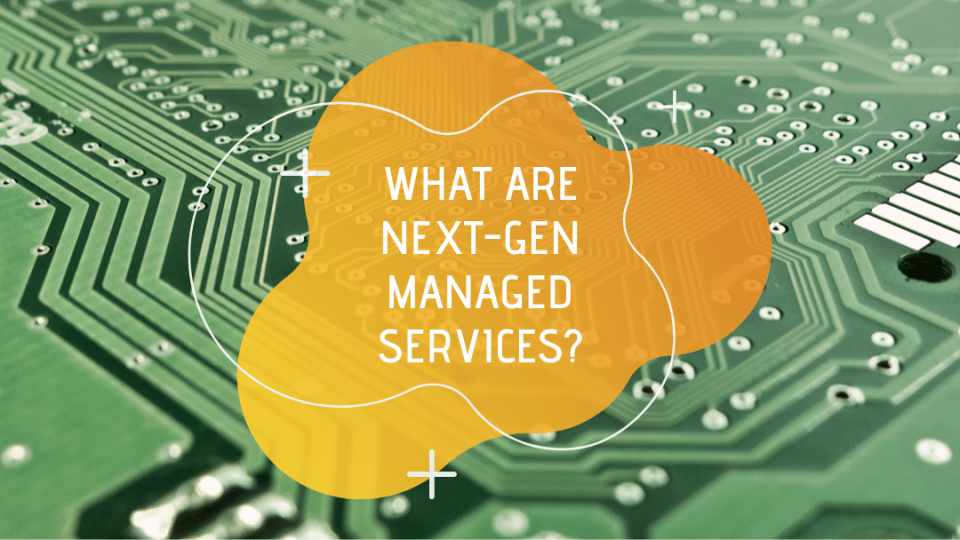October 10, 2019
What are Next-Gen Managed Services?

Trends in data management, cybersecurity, and cloud-based solutions over the past several years have created a very important need for both SMBs and enterprises – next-gen managed services.
IT management has become a lot more than reducing downtime and resolving support tickets. An MSP, or Managed Services Provider, is the solution many companies have been turning to for help with the myriad of tasks their internal (or non-existent) IT team is attempting to handle.
Next-Gen Managed Services
Partnering with an MSP can reduce costs, alleviate strain on your internal team, strengthen your security defences, streamline your data management, give you confidence in your compliance, and make your business more agile.
A MSP works alongside your IT team, or independently, to provide the following Next-Gen Managed Services:
Securing your network and infrastructure against threats such as cybersecurity attacks by creating backups and disaster recovery plans.
Providing technical support and education to your business and staff.
Working with you and your team to create a long-term cloud-based strategy that can handle growth, security, and compliance.
Managing data efficiently and safely, while ensuring compliance.
Setting up automation and intelligent cloud solutions to reduce time spent doing manual management.
Installing and upgrading new software and technology (like if your office is still running on Windows 7, but its end of life is coming January 2020 and your team has no time for the transition.)
Next-Gen MSP vs Traditional MSP: What’s the difference?
IT management is not new, we’ve been doing it for over 10 years, so what’s so special about next-gen services?
Traditional MSP Model
This model benefited companies well when IT was still very much routine management and technical support.
The plan was reactive – clients reach out to the Managed Services Provider with a support ticket (or however) when they need help fixing something, making an update, etc.
The infrastructure was divided with several potential combinations between internal teams, on-premises servers, private and public servers, cloud-based solutions, and other third-parties.
A main limitation of this model is that your internal team drives the security, software choices, and data management decisions, so there is a lot of relying on their expertise and availability.
Next-Gen MSP Model
The next-gen model includes one very important difference: the development of a long-term, multi-cloud strategy that takes modern challenges and solutions into consideration (like cybersecurity threats.)
This model is growing in popularity because it can reduce labour hours, reduce disruption in the workplace, and increase agility when deploying code and other updates.
Switching from an internal server to a cloud-based solution can make companies nervous – the cloud brings a lot of security challenges. That’s why the next-gen model is a good updated solution: the cloud storage and software your business needs to evolve, with the security and compliancy you need to be protected.
“The percentage of enterprises that have a multi-cloud strategy grew to 84 percent vs. 81 percent in 2018. Those planning a hybrid cloud strategy grew to 58 percent from 51 percent in 2018.”
Do I Need Next-Gen Managed Services?
Most companies typically decide to make the move from on-premises to cloud services when the bills get too high, but there are many reasons you may need next-gen managed services:
Your technical team is so focused on product development and other projects to have time for IT management.
Cloud-based solutions are too complex for your company to deploy without a third-party company.
You’re a small business that doesn’t have the budget to deploy this kind of solution.
You and your team spend too much time fixing a server that’s gone down or updating technology and need help.
You need guidance on compliance standards like HIPPA and PCI DSS.
You need experienced assistance improving your cybersecurity defences and managing your firewall.
You spend too much time with routine IT management and need to free up your team with automation.
You can’t afford to invest in the latest security and cloud-based software solutions that your business needs to be current.
You can’t keep up with the implementation of new cloud features and software updates that are required.
If any of these scenarios sound familiar, you should speak to our team today about an IT solution that fits your business.
“There are an average of 1,600 features being launched by Amazon Web Services on a yearly basis…”
Does your business have a next-gen strategy yet?
Our FoxNet Team has over 10 years of experience solving IT problems and we were named one of Canada’s Top 100 Service Providers by CDN Industry recognition. If you have questions, please reach out today.
You can also spend some time with our team getting some Tips from the Bar! Here’s an inside look at just how next-gen managed services work:
<iframe width="1120" height="630" src="https://www.youtube.com/embed/YWFz8q3_pnc" title="FoxNet Tips from the Bar 3.03 Managed Services" frameborder="0" allow="accelerometer; autoplay; clipboard-write; encrypted-media; gyroscope; picture-in-picture; web-share" allowfullscreen></iframe>
Continue Learning
Introducing the Next-Generation for Storage
Windows 7 End of Life, Cyberattacks on a Hospital, and More
Protecting Data with Cloud Solutions
Maintaining Trust in an Age of Ransomware



